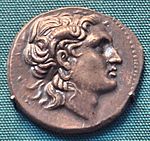Lysimachus facts for kids
Quick facts for kids Lysimachus |
|
|---|---|
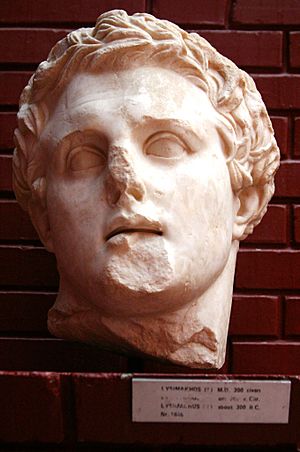
Hellenistic marble bust of Lysimachus at the Ephesus Archaeological Museum, dated circa 300 BC.
|
|
| King of Thrace | |
| Reign | 306–281 BC |
| Predecessor | Alexander IV |
| Successor | Ptolemy Keraunos |
| King of Asia Minor | |
| Reign | 301–281 BC |
| Predecessor | Antigonus I Monophthalmus |
| Successor | Seleucus I Nicator |
| King of Macedon with Pyrrhus of Epirus |
|
| Reign | 288–281 BC |
| Predecessor | Demetrius I Poliorcetes |
| Successor | Ptolemy Keraunos |
| Born | c. 360 BC Crannon or Pella |
| Died | February 281 BC (aged approximately 79) Corupedium, near Sardis (modern-day Salihli, Manisa, Turkey) |
| Burial | Lysimachia, Thrace (modern-day Kavakköy, Çanakkale, Turkey) |
| Consort | |
| Issue Among others |
|
| Father | Agathocles |
Lysimachus (born around 360 BC – died 281 BC) was an important officer and trusted friend of Alexander the Great. After Alexander's death, Lysimachus became one of the "Diadochi," which means "successors." These were the generals who divided Alexander's huge empire among themselves. In 306 BC, Lysimachus became King of Thrace, Asia Minor, and later Macedon.
Contents
Early Life and Military Career
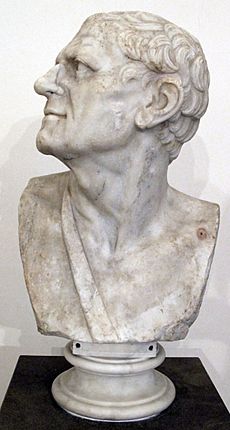
Lysimachus was born around 360 BC. His family came from Thessaly, a region in ancient Greece. However, they were citizens of Pella, the capital city of Macedonia. His father, Agathocles, was a respected nobleman and a close friend of Philip II of Macedon, Alexander the Great's father.
Lysimachus and his brothers grew up in the Macedonian court in Pella. They were educated there and held important positions in Alexander's inner circle.
One famous story says that Alexander once locked Lysimachus in a room with a lion as punishment. Lysimachus fought the lion with his bare hands and defeated it. After this, Alexander respected him even more. Some coins made during Lysimachus's rule even show his image on one side and a lion on the other.
Lysimachus was one of Alexander's personal bodyguards, called a Somatophylakes. He served during Alexander's campaigns in Persia and India. In 324 BC, he received a special crown for his bravery in India.
After Alexander the Great died in 323 BC, Lysimachus was given control of Thrace as a strategos (a military general and governor). He faced some challenges from the local Thracian king, Seuthes, but managed to keep control.
Becoming a King: The Diadochi Wars
In 315 BC, Lysimachus joined forces with other powerful generals like Cassander, Ptolemy, and Seleucus. They fought against another strong general, Antigonus. Antigonus tried to distract Lysimachus by encouraging Thracian and Scythian tribes to rebel against him. Despite this, Lysimachus successfully strengthened his power in the eastern parts of his lands.
In 309 BC, Lysimachus founded a new city called Lysimachia. It was built in a strategic location, acting as a defense against the local tribes.
Around 306 or 305 BC, Lysimachus declared himself king, following the example of Antigonus. This was a big step, as it meant he was no longer just a governor but a ruler in his own right.
In 302 BC, Lysimachus joined a second alliance against Antigonus. He led his troops into Asia Minor and faced little resistance. He later married Amastris, the widowed queen of Heraclea. In 301 BC, Lysimachus and Seleucus defeated Antigonus at the Battle of Ipsus, where Antigonus was killed. Lysimachus gained a large share of Antigonus's lands, including Lydia, Ionia, and Phrygia.
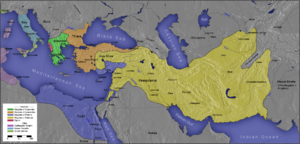
Lysimachus felt that Seleucus was becoming too powerful. So, he formed an alliance with Ptolemy, marrying Ptolemy's daughter, Arsinoe II of Egypt. Amastris, his previous wife, had already divorced him.
When Antigonus's son, Demetrius I, started new conflicts in 297 BC, Lysimachus took control of Demetrius's towns in Asia Minor. In 294 BC, they made peace, and Demetrius was recognized as the ruler of Macedonia.
Lysimachus tried to expand his kingdom beyond the Danube river. However, he was defeated and captured by the Getae king Dromichaetes. Dromichaetes later released Lysimachus in 292 BC, and they made a friendly agreement. Lysimachus gave back the lands he had captured along the Danube.
In 287 BC, Lysimachus and Pyrrhus of Epirus invaded Macedonia together. They drove Demetrius out of the country. For a short time, Lysimachus and Pyrrhus ruled Macedonia together. But in 285 BC, Lysimachus expelled Pyrrhus and took full control of Macedonia for himself.
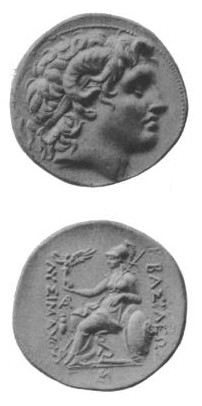
Later Years and Death
The final years of Lysimachus's life were filled with family problems. His wife, Arsinoe II, wanted her own sons to inherit the throne instead of Lysimachus's first son, Agathocles. She worked with her half-brother, Ptolemy Keraunos, to accuse Agathocles of plotting against Lysimachus. Sadly, Lysimachus believed them and had Agathocles killed.
This terrible act made many people angry. Several cities in Asia Minor rebelled against Lysimachus, and many of his trusted friends left him. Agathocles's wife and children fled to Seleucus, who then invaded Lysimachus's territory in Asia Minor.
In 281 BC, Lysimachus crossed into Lydia to face Seleucus. They fought a major battle called the Battle of Corupedium. Lysimachus was killed in this battle. His body was found on the battlefield a few days later, protected by his loyal dog. Lysimachus's body was given to another of his sons, Alexander, who buried him in Lysimachia.
Marriages and Children
Lysimachus was married three times:
- His first wife was Nicaea, a Macedonian noblewoman and daughter of the powerful regent Antipater. They married around 321 BC. They had three children:
* A son, Agathocles * A daughter, Eurydice * A daughter, Arsinoe I
- His second wife was the Persian Princess Amastris. They married in 302 BC, but their marriage was short. Lysimachus divorced her around 300/299 BC.
- His third wife was the Ptolemaic Greek Princess Arsinoe II. They married around 300/299 BC and stayed together until his death in 281 BC. Arsinoe II gave Lysimachus three sons:
* Ptolemy I Epigonos * Lysimachus * Philip
Lysimachus also had another son named Alexander with an Odrysian woman.
Images for kids
See also
 In Spanish: Lisímaco de Tracia para niños
In Spanish: Lisímaco de Tracia para niños
- Belevi Mausoleum


